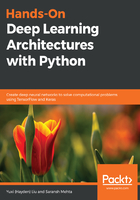
Machine learning
Artificial intelligence prior to machine learning was just about writing rules that the machine used to process the provided data. Machine learning made a transition. Now, just by providing the data and expected output to the machine learning algorithm, the computer returns an optimized set of rules for the task. Machine learning uses historic data to train a system and test it on unknown but similar data, beginning the journey of machines learning how to make decisions without being hard coded. In the early 90s, machine learning emerged as the new face of artificial intelligence. Larger datasets were developed and made public to allow more people to build and train machine learning models. Very soon a huge community of machine learning scientists/engineers developed. Although machine learning algorithms draw inference from statistics, what makes it powerful is the error minimization approach. It tries to minimize the error between expected output provided by the dataset and predicted algorithm output to discover the optimized rules. This is the learning part of machine learning. We won't be covering machine learning algorithms in this book but they are essentially divided into three categories: supervised, unsupervised, and reinforcement. Since deep learning is also a subset of machine learning, these categories apply to deep learning as well.